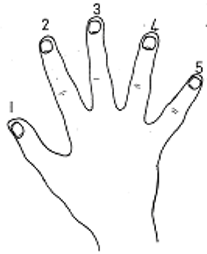| << Chapter < Page | Chapter >> Page > |
The topics chosen for the modules in Grade 1 are all related to stories which reflect the learners’ experience in the world in which they are growing up. They are relevant to both boys and girls.
Much depends on the number of times the learners hear the stories and rhymes and the provision made for the repetition of the vocabulary introduced. At first this is done classically. As the learners become more familiar with English they can communicate with a friend. Eventually they will want to tell the teacher and answer questions about the texts.
The educators must keep in mind that there may be many/some learners in the class who are still only at the listening stage, but with the necessary encouragement and praise they will soon join in and begin speaking in English.
Time scheduled for the modules 1 to 8
It is suggested that the average learners complete all eight modules during the year, finishing ± two modules per term.
Allow the slower learners to proceed at their own pace when doing the written activities but expose them to all the listening and speaking activities with the class.
The quick learners can be extended and given more tasks and activities to complete.
“The home” is the topic introduced with the story of the three little pigs.
The sequential pictures will help the learners to retell the story in the correct order once they have listened to the story several times.
Vocabulary about the house is introduced as well as the family living in the house. Learners are exposed to “reading” and “writing” with activities relating to number, shape, direction and ordering.
The lists of words introduced in this module serve to consolidate the speaking vocabulary rather than to facilitate their reading ability. Many learners will however pick up “reading” incidentally.
Integration of themes
In the context of the home all learners should be able to live in a respectable home with electricity and running water available.
All learners should be made aware of abuse even in the context of home and family life. It is primarily the parents responsibility to feed and clothe the learners to the best of their ability.
1. This is the father, tall and stout. (thumb)
2. This is the mother, with children about. (all the fingers)
3. This is the brother, tall you see,
4. This is the sister, with the dolly on her knee.
5. This is the baby, still to grow,
1-5 And here is the family all in a row.
(Author unknown)

| LO 2.2 | LO 5.1.2 |
My Daddy can . . .

My Mummy can . . .

My brother can . . .

My sister can . . .

| LO 1.1.3 | LO 2.6 | LO 6.5 |
|
(Draw) My bedroom |
|
My lounge |
|
My dining room |
|
My kitchen |
|
My bathroom |
| LO 2.6 | LO 3.1.3 | LO 6.2 |

| my bedroom | my lounge |
| my dining room | my kitchen |
| my bathroom | not furniture |
| LO 5.3.1 | LO 5.3.3 |

1. This little pig went to market.

2. This little pig stayed at home.

3. This little pig had roast beef.

4. This little pig had none.

5. This little pig cried, “Wee, wee!” all the way home.

| LO 1.1.3 | LO 2.2 |
Learning Outcome 1: LISTENING : The learner is able to listen for information and enjoyment and respond appropriately and critically in a wider range of situations.
Assessment Standard 1.1: We know this when the learner understands short, simple stories:
1.1.3 draws a picture of the story;
Learning Outcome 2: SPEAKING : The learner is able to communicate confidently and effectively in spoken language in a wide range of situations.
Assessment Standard 2.2: We know this when the learner memorises and performs songs and action rhymes with the right intonation, rhythm and pronunciation;
Assessment Standard 2.6: We know this when the learner pronounces familiar words clearly;
Learning Outcome 3: READING AND VIEWING : The learner is able to read and view for information and enjoyment and respond critically to the aesthetic, cultural and emotional values in texts.
Assessment Standard 3.1: We know this when the learner use pictures to understand written texts:
3.1.3 uses illustrations to understand simple captions in story books;
Learning Outcome 4: WRITING : The learner is able to write different kinds of factual and imaginative texts for a wide range of purposes.
Assessment Standard 4.3: We know this when the learner writes lists with titles.
Learning Outcome 5: THINKING AND REASONING : The learner is able to use language to think and reason, and access, process and use information for learning.
Assessment Standard 5.1: We know this when the learner uses language for thinking;
5.1.2 number;
Assessment Standard 5.3: We know this when the learner uses language for thinking;
5.3.1 identifies similarities and differences;
5.3.3 classifies things.
Learning Outcome 6: GRAMMAR AND VOCABULARY : The learner knows and is able to use the sounds, vocabulary and grammar of the language to create and interpret texts.
Assessment Standard 6.2: We know this when the learner understands simple sentences in oral texts;
Assessment Standard 6.5: We know this when the learner understands some models in oral texts.

Notification Switch
Would you like to follow the 'English first additional language grade 1' conversation and receive update notifications?